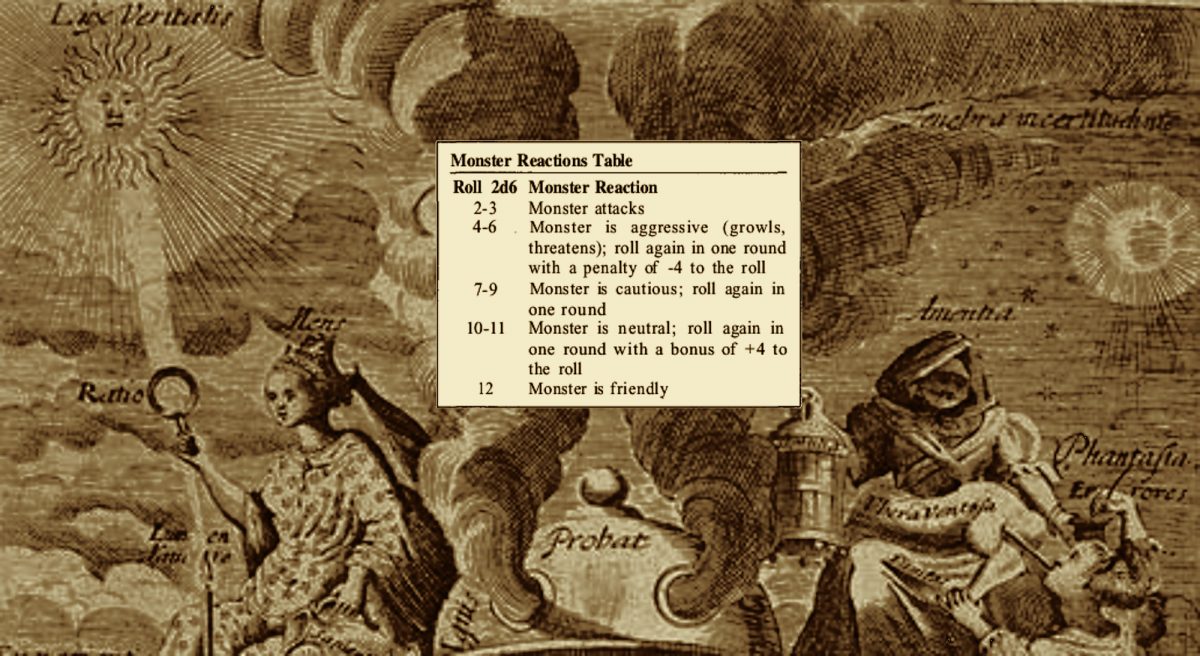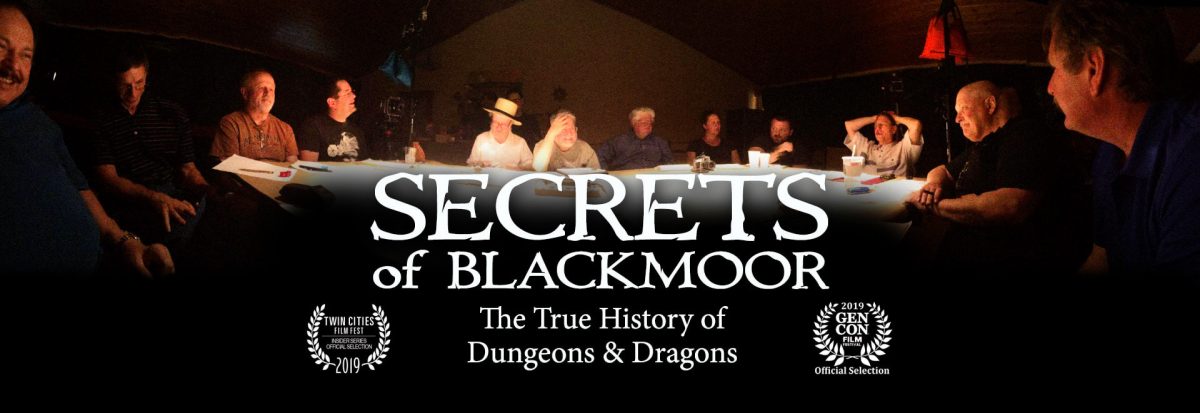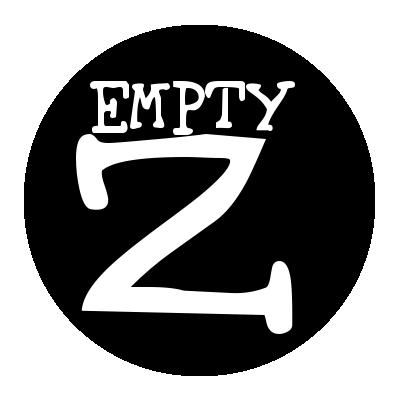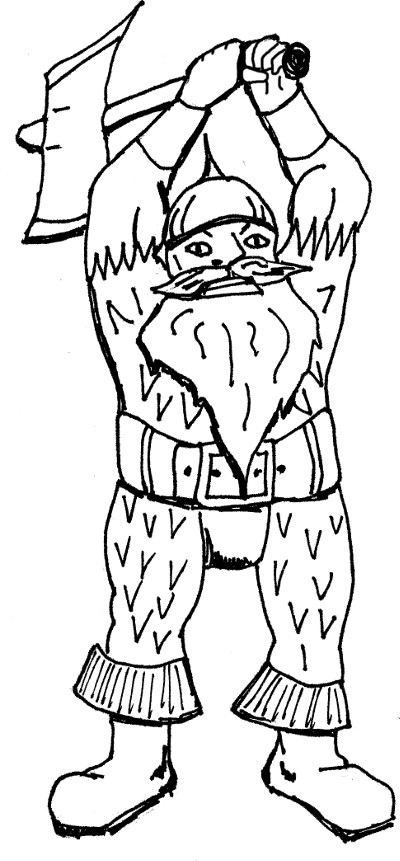The following monster reaction chart from the Mentzer red box edition of D&D shows up frequently on blogs and twitter. Every time I see it, I wonder about the chances of each end result. So, I worked out the chances by doing the multiplication.
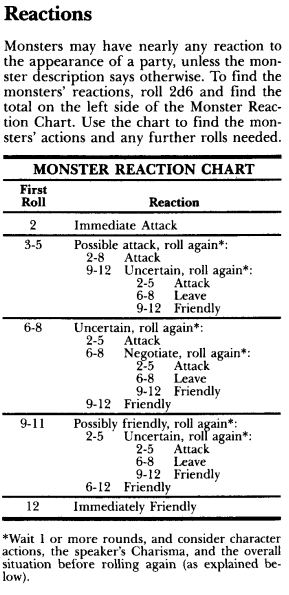
For example, roll a 3 for a possible attack. Then roll a 9, uncertain. Finally, roll a 5 for an attack. That’s a 25% chance of rolling 3-5. A second roll of 9-12 happens 28% of the time. A third roll of 5 also has a chance of 28%. That works out to 0.15%. However, there are many rows that end up as attack that must be added together. The following table reproduces the original with d100.
| d100 | Reaction | Chance |
|---|---|---|
| 00‑02 | Immediate Attack | 3% |
| 03‑42 | Attack | 40% |
| 43‑56 | Leave | 14% |
| 57‑98 | Friendly | 40% |
| 99‑00 | Immediately Friendly | 3% |
A roll of a 2 on 2d6 is really 2.78%. The leave result should really be 14.95%, but I donated remainders to the first and last results to keep it to increments of 1%.
Other Basic Editions
Of course, this got me wondering about other editions. The chart from the third volume of the little brown books looks like the following.
| 2d6 | Reaction | Chance |
|---|---|---|
| 2‑5 | Negative | 27.8% |
| 6‑8 | Uncertain | 44.4% |
| 9‑12 | Positive | 27.8% |
With such a high chance of an uncertain result, maybe it’s trying to tell the DM to figure it out himself. But said DM might say to himself, “uncertain, eh? I wonder which way they are leaning.” And then he’ll roll again. Maybe that’s how we got the nested Mentzer table.
Next, I looked at what’s in the Holmes book, which breaks up the negative and positive reactions into less likely immediate reactions. Nearly half the time, though, you’re rolling again.
| 2d6 | Reactionq | Chance |
|---|---|---|
| 2 | Attacks immediately! | 2.7% |
| 3‑5 | Hostile reaction | 25.0% |
| 6‑8 | Uncertain, make another offer, roll again | 44.4% |
| 9‑11 | Accepts offer, friendly | 25.0% |
| 12 | Enthusiastic, volunteers help | 2.7% |
Presumably only a roll of 6-8 requires a re-roll. I’d probably interpret a 6 as being vaguely hostile. Now consider the Rules Cyclopedia.
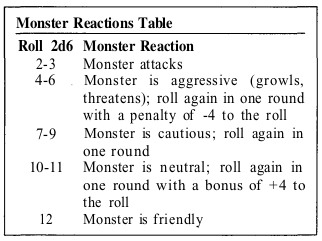
This table has a bias for monsters being hostile or at least not helpful. That probably makes more sense for monsters in a dungeon into which a party of adventurers just showed up, busting down doors. I appreciate how this table has a memory for previous results. Imagine first getting a 6. The monsters growl in response. The players have a chance to do something. If they keep talking, though, the best they can do is push the monsters to a cautious state.
| 2d6 | Reaction | Chance |
|---|---|---|
| 2‑3 | Monster Attacks | 8.33% |
| 4‑6 | Monster is aggressive | 33.33% |
| 7‑9 | Monster is cautious | 41.67% |
| 10‑11 | Monster is neutral | 13.89% |
| 12 | Monster is friendly | 2.78% |
The rules for using this table go into more detail. Don’t apply any charisma bonus on the first roll, but do afterwards. Adjust based on what the characters are doing. A cowardly or outmatched monster should run rather than attack. Lastly, never roll more than three times. After that, the monsters attack or retreat.
Newer Editions
Following is the chart provided in the AD&D Dungeon Masters Guide.
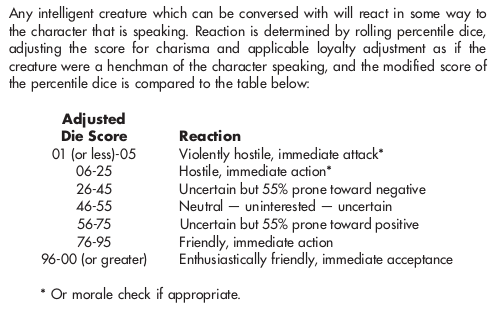
Interestingly, Gygax provides a percentile chart in AD&D. Though not explicitly stated, I assume an uncertain result should cause a second roll with a bonus or penalty of 55%. That seems to mean that a roll of 45 prevents getting back to a neutral state unless some other bonuses are in effect. In the chart below, you can see how the AD&D table is symmetric, not biased towards hostility from monsters.
| d100 | Reaction | Chance |
|---|---|---|
| 01‑05 | Violently hostile, immediate attack or check morale | 5% |
| 06‑25 | Hostile, immediate action or check morale | 20% |
| 26‑45 | Uncertain but prone towards negative | 20% |
| 46‑55 | Neutral, uninterested or uncertain | 10% |
| 56‑75 | Uncertain but prone towards positive | 20% |
| 76‑95 | Friendly, immediate action | 20% |
| 96‑00 | Enthusiastically friendly | 5% |
Since my game runs on Basic Fantasy, I also computed percentages for the reaction table from that game. The table is presented as being for monsters.
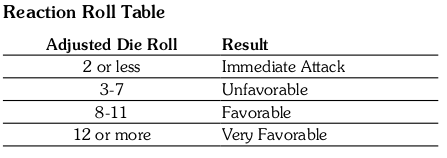
The results are only slightly biased towards hostility. It’s closest to OD&D.
| 2d6 | Reaction | Chance |
|---|---|---|
| 2 | Immediate Attack | 2.78% |
| 3‑7 | Unfavorable | 55.56% |
| 8‑11 | Favorable | 38.89% |
| 12 | Very Favorable | 2.78% |
The AD&D 2E rules use 2d10 and a cross reference against player stance (friendly, indifferent, threatening hostile) to produce the monster stance, which produces the same four stances plus flight. It looks like rolling for monster reactions went away in 3E. I don’t see it in 5E, either.
Comparing these methods, I’m inclined to adapt the Rules Cyclopedia ideas for my campaign. I like the idea of the dice pushing me in a direction when it’s not obvious how the foes should react. I also like the idea of the exchange playing out over three rolls.
Leon’s Reaction Table
Here’s what I plan go with in my game.
| 2d6 | Reaction |
|---|---|
| 2‑3 | The time for talk is over. Check morale. Failure means flight or surrender. Otherwise, attack immediately. |
| 4‑6 | Someone will get their head bashed in. Attitude is aggressive and negative. Apply -4 to the next check if there’s room for negotiation. Otherwise, it’s fight or flight. |
| 7‑9 | Clear and present danger. Cautious and aware of possible trouble. Disengage without violence if possible, or provide a final warning. |
| 10‑11 | Trust and verify. Neutral and open to a fair exchange. Apply +4 to the next check. Any final offers are take-it-or-leave-it. |
| 12 | This could be the beginning of a beautiful friendship. Relaxed presumption of courtesy. |
Move the interaction through three phases, generally divided by exchanges of dialog but not necessarily only one round long.
- Determine initial attitude without the benefit or penalty of charisma. Apply ±4 for any non-verbal biases, such displaying the symbols of an enemy tribe or being a filthy barbarian among perfumed concubines.
- Roll again, applying relevant charisma bonuses. Ignore the biases from first impressions, but include any new information. Friendly gestures or bribes promote a friendly reaction. Rude or aggressive behavior promotes negative reactions. Consider the actions of participants.
- Make one, final roll. Conclude the encounter with role-playing or combat.
